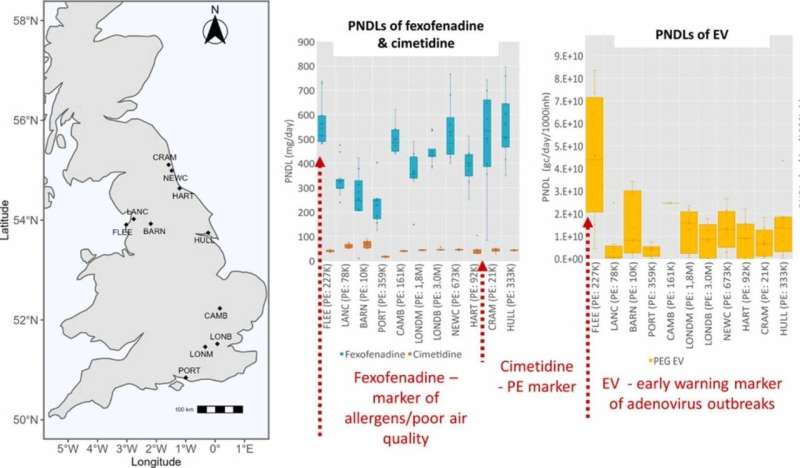Next epidemic could be spotted early in wastewater, say scientists

Researchers analyzing wastewater say that routine monitoring at sewage treatment works could provide a powerful early warning system for the next flu or norovirus epidemic, alerting hospitals to prepare and providing public health agencies with vital health information.
In the first large scale and comprehensive wastewater-based epidemiology (WBE) study in the U.K., scientists at the University of Bath, Bangor University and the U.K. Heath Security Agency analyzed wastewater from 10 cities for both chemical and biological markers of health, including pesticides, pharmaceuticals and disease-causing viruses. The study is published in the Journal of Hazardous Materials.
They collected samples from each location at hourly intervals over 24 hours on nine days in November 2021. The samples for each day were pooled before being processed and analyzed for trace chemical markers using mass spectrometry techniques.
The samples were also analyzed to detect any genetic material from viruses (SARS-CoV-2, norovirus and adenovirus). The total sampling catchment area equated to a population of around 7 million people.
Detecting trace chemicals
Using highly sensitive chemical analysis that could distinguish between very similar markers, the researchers were able to tell whether pharmaceuticals had passed through the human body or had been directly disposed into the wastewater system.
They could also identify whether chemicals such as pesticides had been ingested through food or had washed into the wastewater system from agricultural land.
The team observed that differences in levels of chemical markers were mostly dependent on the size of population in the catchment area, however there were some outliers.
For example in one city, there was a much higher concentration of ibuprofen found in the water, compared with other cities, suggesting direct disposal from industrial waste.
Identifying disease outbreaks
The researchers detected localized outbreaks of norovirus, COVID-19 and flu, but could also correlate them with spikes in usage of over-the-counter painkillers such as paracetamol.
The results indicate that analyzing wastewater on a large scale in this way, dubbed wastewater-based epidemiology, could spot new outbreaks of diseases in communities early on, before large numbers were admitted into hospitals.
Professor Barbara Kasprzyk-Hordern, from the Water Innovation Research Center and Institute for Sustainability at the University of Bath, led the chemistry work on the project. She said, “Most people reach for the paracetamol when they first get sick, and try to treat their illnesses at home.
“So looking for large spikes in paracetamol use could give an early indication that there may be an infectious disease outbreak in the community.
“We can also detect markers of inflammation and so look for any possible links of poor health with exposure to harmful chemicals, such as pesticides from food or industrial sources of chemicals.
“Our study has shown that only 10 daily samples from 10 wastewater treatment plants are needed to provide anonymous and unbiased information on the health of 7 million people—this is much cheaper and faster than any clinical screening process.
“This could, therefore, potentially be a very powerful tool for giving a holistic understanding of public health of different communities.”
Professor Davey Jones, who led a team at Bangor University analyzing the wastewater for viruses, said, “Norovirus and seasonal flu have always been a huge problem in hospitals each winter; now COVID-19 has added to this problem.
“Our proof-of-concept study has shown the potential for wastewater-based epidemiology to provide an early warning surveillance system for these and other diseases, which would enable hospitals to prepare for outbreaks in the local area.”
Matthew Wade, from the U.K. Health Security Agency, said, “This has been a fantastic collaboration of chemists, biologists and Government agencies, working with multiple water companies to collect important data on both chemical and biological markers from different parts of the U.K.
“We are delighted to be part of this project and look forward to developing the potential of this public health tool even further in the future.”
More information:
Barbara Kasprzyk-Hordern et al, Wastewater-based epidemiology for comprehensive community health diagnostics in a national surveillance study: Mining biochemical markers in wastewater, Journal of Hazardous Materials (2023). DOI: 10.1016/j.jhazmat.2023.130989
Journal information:
Journal of Hazardous Materials
Source: Read Full Article
